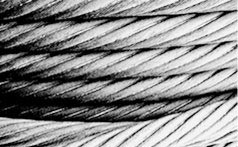There are two main methods for non-destructive inspection of wire ropes. The most commonly used is visual inspection. During this process, the inspector will grab the rope with a light rag and then rub the cloth over the length of the cable. The external wire that is broken will stick up (porcupine). As the inspector feels the little prick, they will stop to analyze the condition of this section of rope closely .
.
>Unfortunately, a broken wire may not porcupine, so that is why another test must be implemented. Inspectors will move along the rope in two to three feet segments while examining each section. This method can also be complicated because cables are well lubricated with grease.
Another testing method compares current ropes to how they initially looked. An inspector will examine the diameter between the two cables. If the width has changed that is usually an indicator of either internal or external rope damage. Like the other methods above, this test is not complete. Not all breaks will alter the size of the rope’s diameter.
Check for any visible signs of distributed losses of metallic cross sections. Corrosion, abrasion, and wear commonly cause this problem. It is possible to check for internal damage by inserting a marlin spike underneath two strands—then rotate to lift strands and open rope.
It is rather difficult to detect internal rope damage, so visual inspections only provide a limited amount of information about the ropes. It is still a valuable tool for the evaluation of rope degeneration.
Wire Rope
We provide a full line of wire ropes, vrope, rigging supplies, and nylon slings. Call us today for more information.
Related Reading